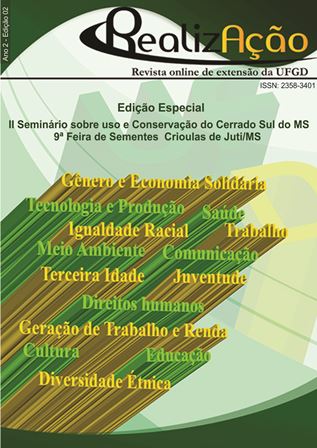Catatuê Project: making toys using recyclable materials: teaching-learning and recreational activities
Keywords:
Recycling , Toys , Environmental educationAbstract
The excessive production of waste on the planet is a consequence of actions caused by excessive consumerism and the lack of awareness on the part of the world's population. Recycling is a way of returning to nature in a less impactful way what was taken from it. Reusing disposable materials can be a concrete and practical alternative to develop the process of environmental awareness in children. For child development, interaction with the environment is fundamental. Therefore, the introduction of activities involving the reuse of materials in schools is of fundamental importance for the development of a quality environmental education. Considering these aspects, the present work aimed to make toys using disposable materials with children between ten and twelve years old. The workshops basically consisted of teaching children how to make three types of toys and later teaching them how to play with the toys they made. Among the materials used were PET bottles, newspapers and old magazines. It can be concluded that, although understanding the importance of recycling and environmental preservation is an ongoing process, the presentation of the aforementioned themes and the possibility of building their own toys aroused the children's curiosity and tended to bear fruit.
Downloads
References
AGUIAR, G. N. Reciclar, recriar e transformar para poder brincar na educação. 2010
ALEGRO, R. C. Conhecimento prévio e aprendizagem significativa de conceitos históricos no Ensino Médio. Tese de doutorado. Marília, 2008.
BRASIL. Ministério do Planejamento, Orçamento e Gestão. Instituto Brasileiro de Geografia e Estatística. Pesquisas especiais. 2013.
DELEPOSTE, S. M. A Importância dos Jogos e Brincadeiras na Clínica Psicopedagógica. 2013.
FERNANDES, M. C.; ALMEIDA JUNIOR, A. S. Jogos e Brinquedos. (2008).
MOREIRA, M. A. Teorias de aprendizagem. São Paulo: EPU, 1999.
NOVAES, T. Aterro sanitário de Canabrava, em Salvador. 2013.
PEDROSO, A. C.; BARRETO, J. M.; MALAQUIAS, J.S.S.; PINTO, L.M.; Papel do brinquedo no desenvolvimento infantil. (Trabalho de Conclusão de curso). Faculdades Integradas do Vale do Ribeira. São Paulo, 2008.
QUADROS, A. Educação ambiental: iniciativas populares e cidadania. (Trabalho de conclusão de curso). Santa Maria, RS. 2007.
ROOS, A.; BECKER, E.L.S. Educação ambiental e sustentabilidade. Revista Eletrônica em Gestão, Educação e Tecnologia Ambiental, Santa Maria, 2012.
SEBRAE. Comece certo. Usina de reciclagem. São Paulo, 2010.
SOUZA, I. V. Programa Sócio Educativo: Oficina de contação de história e construção de brinquedos usando sucata. Florianópolis. 2002. RealizAção, Dourados, MS, v.1, n. 2, p 50-59 / agosto /2014
VIGOTISKI, L. S. Pensamento e linguagem. São Paulo, 1987.
WEINGRILL, C. Práticas empresariais de responsabilidade social das empresas. Instituto ETHOS, São Paulo, 2003.
Downloads
Published
How to Cite
Issue
Section
License
Copyright (c) 2014 Nayara Moreno Martins, Nayara Fernanda Lisbôa Garcia, Zefa Valdivina Pereira, Valter Vieira Alves Junior

This work is licensed under a Creative Commons Attribution-NonCommercial-ShareAlike 4.0 International License.
Autores que publicam nesta revista aceitam as normas de publicação, bem como, concordam com os seguintes termos:
(a) O Conselho Editorial se reserva ao direito de efetuar, nos originais, alterações da Língua portuguesa para se manter o padrão culto da língua, respeitando, porém, o estilo dos autores.
(b) Autores mantêm os direitos autorais e concedem à revista o direito de primeira publicação, com o trabalho simultaneamente licenciado sob a Creative Commons Atribuição-NãoComercial-CompartilhaIgual 4.0 Internacional que permite: Compartilhar — copiar e redistribuir o material em qualquer suporte ou formato e Adaptar — remixar, transformar, e criar a partir do material. A Creative Commons Atribuição-NãoComercial-CompartilhaIgual 4.0 Internacional considera os termos seguintes:
- Atribuição — Você deve dar o crédito apropriado, prover um link para a licença e indicar se mudanças foram feitas. Você deve fazê-lo em qualquer circunstância razoável, mas de nenhuma maneira que sugira que o licenciante apoia você ou o seu uso.
- NãoComercial — Você não pode usar o material para fins comerciais.
- CompartilhaIgual — Se você remixar, transformar, ou criar a partir do material, tem de distribuir as suas contribuições sob a mesma licença que o original.
- Sem restrições adicionais — Você não pode aplicar termos jurídicos ou medidas de caráter tecnológico que restrinjam legalmente outros de fazerem algo que a licença permita.


